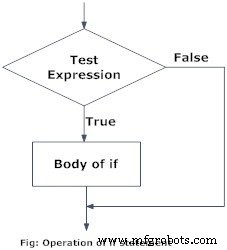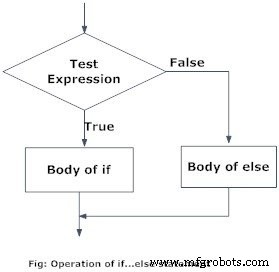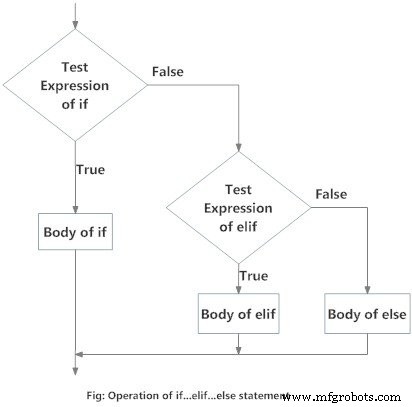Python if...else 语句
Python if...else 语句
在本文中,您将学习使用不同形式的 if..else 语句在 Python 程序中创建决策。
视频:Python if...else 语句
Python 中的 if...else 语句是什么?
当我们想要仅在满足特定条件时执行代码时,就需要做出决策。
if…elif…else 语句在 Python 中用于决策。
Python if 语句语法
if test expression:
statement(s)
在这里,程序评估 test expression 并且仅当测试表达式为 True 时才会执行语句 .
如果测试表达式是 False ,则不执行语句。
在 Python 中,if 的主体 语句由缩进表示。正文以缩进开头,第一条未缩进的行标记结束。
Python 将非零值解释为 True . None 和 0 被解释为 False .
Python if 语句流程图
<图>
示例:Python if 语句
# If the number is positive, we print an appropriate message
num = 3
if num > 0:
print(num, "is a positive number.")
print("This is always printed.")
num = -1
if num > 0:
print(num, "is a positive number.")
print("This is also always printed.") 当你运行程序时,输出将是:
3 is a positive number This is always printed This is also always printed.
在上面的例子中,num > 0 是测试表达式。
if 的正文 仅当计算结果为 True 时才执行 .
当变量 num 等于 3,测试表达式为真,if 正文中的语句 被执行。
如果变量 num 等于 -1,测试表达式为假,if 正文中的语句 被跳过。
print() 语句在 if 之外 块(未缩进)。因此,无论测试表达式如何,它都会执行。
Python if...else 语句
if...else 的语法
if test expression:
Body of if
else:
Body of else
if..else 语句计算 test expression 并将执行 if 的主体 仅当测试条件为 True .
如果条件是False , else 的主体 被执行。缩进用于分隔块。
Python if..else 流程图
<图>
if...else 示例
# Program checks if the number is positive or negative
# And displays an appropriate message
num = 3
# Try these two variations as well.
# num = -5
# num = 0
if num >= 0:
print("Positive or Zero")
else:
print("Negative number") 输出
Positive or Zero
在上面的例子中,当 num 等于 3,测试表达式为真,if 的正文 被执行并且 body of else 被跳过。
如果 num 等于-5,测试表达式为假,else的正文 被执行,if 的主体 被跳过了。
如果 num 等于0,测试表达式为真,if的正文 被执行并且 body of else 被跳过。
Python if...elif...else 语句
if...elif...else 的语法
if test expression:
Body of if
elif test expression:
Body of elif
else:
Body of else
elif 是 else if 的缩写。它允许我们检查多个表达式。
如果 if 的条件 是 False ,它检查下一个 elif 的条件 块等等。
如果所有条件都是False , else 的主体被执行。
几个if...elif...else中只有一个块 块根据条件执行。
if 块只能有一个 else 堵塞。但它可以有多个elif 块。
if...elif...else的流程图
<图>
if...elif...else 示例
'''In this program,
we check if the number is positive or
negative or zero and
display an appropriate message'''
num = 3.4
# Try these two variations as well:
# num = 0
# num = -4.5
if num > 0:
print("Positive number")
elif num == 0:
print("Zero")
else:
print("Negative number") 当变量 num 是正数, 正数 被打印出来了。
如果 num 等于0, 零 被打印出来了。
如果 num 是负数, 负数 被打印出来了。
Python 嵌套 if 语句
我们可以有一个 if...elif...else 另一个 if...elif...else 中的语句 陈述。这在计算机编程中称为嵌套。
任意数量的这些语句都可以相互嵌套。缩进是确定嵌套级别的唯一方法。它们可能会让人感到困惑,因此除非必要,否则必须避免使用它们。
Python 嵌套 if 示例
'''In this program, we input a number
check if the number is positive or
negative or zero and display
an appropriate message
This time we use nested if statement'''
num = float(input("Enter a number: "))
if num >= 0:
if num == 0:
print("Zero")
else:
print("Positive number")
else:
print("Negative number") 输出 1
Enter a number: 5 Positive number
输出 2
Enter a number: -1 Negative number
输出 3
Enter a number: 0 Zero
Python


